The Photographic Film Processing Chemicals Market is estimated to be valued at USD 1.3 billion in 2025 and is projected to reach USD 2.1 billion by 2035, registering a compound annual growth rate (CAGR) of 5.0% over the forecast period.
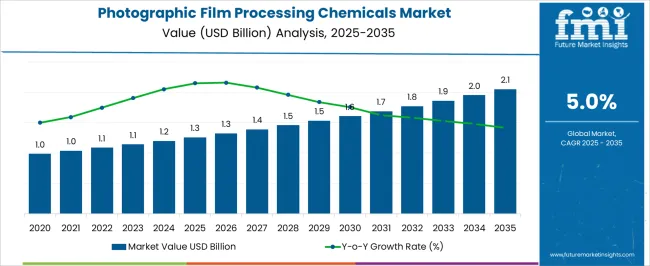
| Metric | Value |
|---|---|
| Photographic Film Processing Chemicals Market Estimated Value in (2025 E) | USD 1.3 billion |
| Photographic Film Processing Chemicals Market Forecast Value in (2035 F) | USD 2.1 billion |
| Forecast CAGR (2025 to 2035) | 5.0% |
The Photographic Film Processing Chemicals market is experiencing a steady revival in niche applications, supported by the resurgence of analog photography, professional film-based imaging, and specialty industrial uses. Despite the widespread adoption of digital photography, demand for film processing chemicals has been sustained by their critical role in maintaining image quality, contrast, and permanence in traditional film.
Growth is being influenced by the rising popularity of vintage photography among professionals and hobbyists, the demand for archival preservation of film content, and their application in educational and creative fields. The market outlook is further strengthened by the integration of film processing in specialized sectors such as medical imaging and security printing where reliability and chemical-based precision remain essential.
Manufacturers are focusing on improving formulations for better environmental compliance, efficiency, and reduced toxicity, which is expected to pave the way for sustained demand As emerging markets continue to explore creative analog solutions, the future growth of this market is anticipated to remain supported by a blend of traditional film usage and innovative chemical improvements.
The photographic film processing chemicals market is segmented by function, type, and geographic regions. By function, photographic film processing chemicals market is divided into Development Agent, Activator, Preservative, Restrainer, Solvents, Neutralizer, Hardener, and Buffer. In terms of type, photographic film processing chemicals market is classified into Sodium Thiosulfate, Sodium Hydroxide, Water, Acetic Acid, Potassium Alum, Potassium Bromide, Sodium Sulfite, and Other Chemicals. Regionally, the photographic film processing chemicals industry is classified into North America, Latin America, Western Europe, Eastern Europe, Balkan & Baltic Countries, Russia & Belarus, Central Asia, East Asia, South Asia & Pacific, and the Middle East & Africa.
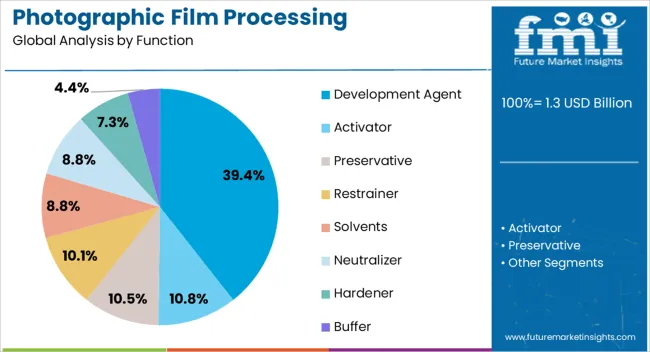
The Development Agent function is expected to account for 39.40% of the total Photographic Film Processing Chemicals market revenue in 2025, making it the leading function-based segment. This dominance has been attributed to the central role of development agents in controlling image clarity, tonal gradation, and photographic sharpness during processing. The ability of development agents to influence the speed, density, and quality of the final image has reinforced their indispensability in the chemical processing cycle.
Their widespread usage in both black and white and color film development processes has further contributed to their leading share, as consistency and adaptability are prioritized by professional film laboratories and hobbyist communities alike. With analog photography continuing to gain momentum as a premium niche, demand for reliable development agents remains strong, especially in creative industries where visual authenticity is valued.
Additionally, ongoing improvements in formulations are reducing toxicity and environmental impact, ensuring compliance with stricter regulations while maintaining performance This balance between effectiveness and sustainability has further cemented the growth trajectory of the development agent segment within the market.
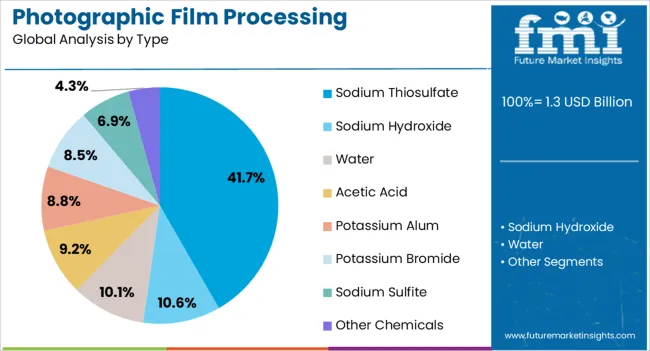
The Sodium Thiosulfate type is anticipated to hold 41.70% of the overall Photographic Film Processing Chemicals market revenue in 2025, making it the most significant type segment. Its leadership has been driven by its critical role as a fixing agent, responsible for stabilizing images by removing unexposed silver halide crystals from the film emulsion. This function ensures the permanence, clarity, and archival quality of photographic prints and negatives, which has made sodium thiosulfate an irreplaceable part of the processing cycle.
Its dominance is further supported by cost-effectiveness, wide availability, and proven reliability across diverse processing environments ranging from professional studios to educational institutions. With analog photography regaining prominence, the need for effective fixing agents has grown proportionately, boosting the share of sodium thiosulfate.
Additionally, its adaptability across both small-scale and industrial-scale processing has reinforced its presence in the market Future growth is expected to be further supported by efforts to refine its formulations for safer handling and enhanced efficiency, ensuring that sodium thiosulfate continues to be a cornerstone in the film processing chemicals market.
Photographic film processing chemicals are the chemicals used in the process of making the latent image visible and then permanent through the film processing. Photographic film processing chemicals are used as development agents, activators, preservatives, restrainers, solvents, neutralizers, hardeners and buffers. Some of the photographic film processing chemicals include sodium thiosulfate, sodium hydroxide, water, acetic acid, potassium alum, potassium bromide and sodium sulfite.
Sodium thiosulfate is generally used as the photographic fixer while sodium hydroxide is used as the activator. Water is used as the solvent and developer. Acetic acid acts as a stop bath in the photographic processing while potassium alum is used as a hardener for photographic films and papers. Significant growth has been observed in the photographic film processing market, which is expected to drive the global demand for photographic film processing chemicals.
Photographic Film Processing Chemicals Market Drivers
The rapid growth of the photographic film industry has created a surge in the demand for photographic film processing chemicals. Silver halide technology is used for image capturing and various chemicals are required to process an image captured on a photographic film. The use of silver halide technology is expected to continue during the forecast, which is expected to drive the market for photographic film processing chemicals.
The high demand for photography from various sectors such as medical, mining, textile and others is expected to fuel the demand for photographic film processing chemicals. Rising developments in photographic film processing chemicals are accelerating the demand for these chemicals, and are projected to support the demand for photographic film processing chemicals over the forecast period. Europe is one of the leading manufacturers for these chemicals in the world. Therefore, economic growth in the European region acts as driver for the growth of photographic film processing chemicals.
One of the major challenges faced by the global photographic film processing chemicals market is the increasing number of regulations on the use of chemicals. Manufacturers are constantly striving to comply with ongoing and upcoming regulations laid out by the respective regulatory bodies.
Another major challenge faced by the global photographic film processing chemicals industry is the increasing competition from global as well as local players. The technology used in the manufacturing of these chemicals is neither expensive nor critical and therefore, the entry of new players in the market is relatively easy, which implies a high threat from new entrants in the market.
The fluctuating price of raw materials has also been a major cause of concern for the global photographic film processing chemicals market. Changing preferences of consumers may also affect the demand for photographic film processing chemicals during the forecast period.
Manufacturers of photographic film processing chemicals are expanding their businesses through the expansion of their distribution network. They are forming long-term partnerships with distributors to strategically grow in this market.
Innovations and R&D are the major strategies being employed to yield better products in terms of quality and effectiveness. Manufacturers are focusing on the manufacturing of low cost and effective photographic film processing chemicals for customers. They strive to reduce the use of harmful chemicals in the processing of photographic films through continuous research and development.
The global photographic film processing chemicals market is anticipated to be dominated by Asia Pacific with China leading the market in terms production and consumption. China has witnessed an increase in the spending on photographic products, which can be attributed to the higher spending power of the country's population. The high penetration rate in North America is expected to push the consumption of photographic film processing chemicals in the region, which is expected to drive the market in the USA and other North American countries. Europe is expected to follow the USA in terms of demand.
Asia Pacific is projected to be the fastest growing region in the photographic film processing chemicals market. Growth of the photography market and rising end-use industries in Asia Pacific are expected to push the demand for photographic film processing chemicals in the region. The Middle East and Africa region is projected to witness moderate growth in the demand for photographic film processing chemicals over the forecast period.
The photographic film processing chemicals market report is a compilation of first-hand information, qualitative and quantitative assessment by industry analysts, inputs from industry experts and industry participants across the value chain. The report provides in-depth analysis of parent market trends, macro-economic indicators and governing factors along with market attractiveness as per segments. The report also maps the qualitative impact of various market factors on market segments and geographies.
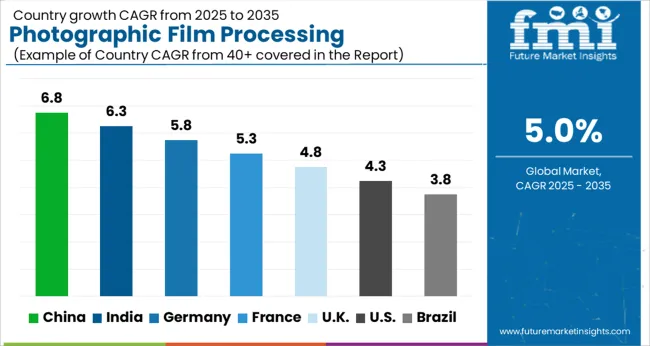
| Country | CAGR |
|---|---|
| China | 6.8% |
| India | 6.3% |
| Germany | 5.8% |
| France | 5.3% |
| UK | 4.8% |
| USA | 4.3% |
| Brazil | 3.8% |
The Photographic Film Processing Chemicals Market is expected to register a CAGR of 5.0% during the forecast period, exhibiting varied country level momentum. China leads with the highest CAGR of 6.8%, followed by India at 6.3%. Developed markets such as Germany, France, and the UK continue to expand steadily, while the USA is likely to grow at consistent rates. Brazil posts the lowest CAGR at 3.8%, yet still underscores a broadly positive trajectory for the global Photographic Film Processing Chemicals Market. In 2024, Germany held a dominant revenue in the Western Europe market and is expected to grow with a CAGR of 5.8%. The USA Photographic Film Processing Chemicals Market is estimated to be valued at USD 471.0 million in 2025 and is anticipated to reach a valuation of USD 714.1 million by 2035. Sales are projected to rise at a CAGR of 4.3% over the forecast period between 2025 and 2035. While Japan and South Korea markets are estimated to be valued at USD 65.7 million and USD 35.1 million respectively in 2025.
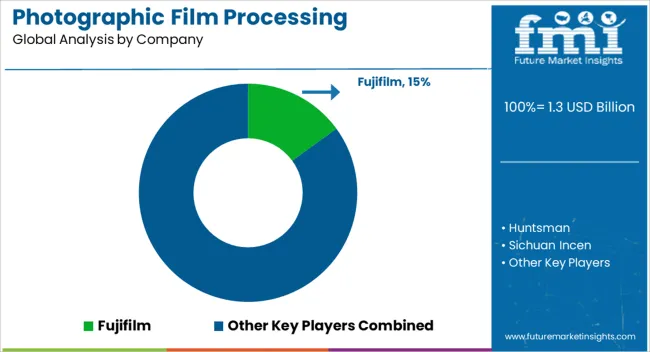
| Item | Value |
|---|---|
| Quantitative Units | USD 1.3 Billion |
| Function | Development Agent, Activator, Preservative, Restrainer, Solvents, Neutralizer, Hardener, and Buffer |
| Type | Sodium Thiosulfate, Sodium Hydroxide, Water, Acetic Acid, Potassium Alum, Potassium Bromide, Sodium Sulfite, and Other Chemicals |
| Regions Covered | North America, Europe, Asia-Pacific, Latin America, Middle East & Africa |
| Country Covered | United States, Canada, Germany, France, United Kingdom, China, Japan, India, Brazil, South Africa |
| Key Companies Profiled | Fujifilm, Huntsman, Sichuan Incen, BASF, Bostick & Sullivan, The Imaging Warehouse, Photo Resource, Moldaners, Allied PhotoChemical, and Harman Technology |
The global photographic film processing chemicals market is estimated to be valued at USD 1.3 billion in 2025.
The market size for the photographic film processing chemicals market is projected to reach USD 2.1 billion by 2035.
The photographic film processing chemicals market is expected to grow at a 5.0% CAGR between 2025 and 2035.
The key product types in photographic film processing chemicals market are development agent, activator, preservative, restrainer, solvents, neutralizer, hardener and buffer.
In terms of type, sodium thiosulfate segment to command 41.7% share in the photographic film processing chemicals market in 2025.






Our Research Products

The "Full Research Suite" delivers actionable market intel, deep dives on markets or technologies, so clients act faster, cut risk, and unlock growth.

The Leaderboard benchmarks and ranks top vendors, classifying them as Established Leaders, Leading Challengers, or Disruptors & Challengers.

Locates where complements amplify value and substitutes erode it, forecasting net impact by horizon

We deliver granular, decision-grade intel: market sizing, 5-year forecasts, pricing, adoption, usage, revenue, and operational KPIs—plus competitor tracking, regulation, and value chains—across 60 countries broadly.

Spot the shifts before they hit your P&L. We track inflection points, adoption curves, pricing moves, and ecosystem plays to show where demand is heading, why it is changing, and what to do next across high-growth markets and disruptive tech

Real-time reads of user behavior. We track shifting priorities, perceptions of today’s and next-gen services, and provider experience, then pace how fast tech moves from trial to adoption, blending buyer, consumer, and channel inputs with social signals (#WhySwitch, #UX).

Partner with our analyst team to build a custom report designed around your business priorities. From analysing market trends to assessing competitors or crafting bespoke datasets, we tailor insights to your needs.
Supplier Intelligence
Discovery & Profiling
Capacity & Footprint
Performance & Risk
Compliance & Governance
Commercial Readiness
Who Supplies Whom
Scorecards & Shortlists
Playbooks & Docs
Category Intelligence
Definition & Scope
Demand & Use Cases
Cost Drivers
Market Structure
Supply Chain Map
Trade & Policy
Operating Norms
Deliverables
Buyer Intelligence
Account Basics
Spend & Scope
Procurement Model
Vendor Requirements
Terms & Policies
Entry Strategy
Pain Points & Triggers
Outputs
Pricing Analysis
Benchmarks
Trends
Should-Cost
Indexation
Landed Cost
Commercial Terms
Deliverables
Brand Analysis
Positioning & Value Prop
Share & Presence
Customer Evidence
Go-to-Market
Digital & Reputation
Compliance & Trust
KPIs & Gaps
Outputs
Full Research Suite comprises of:
Market outlook & trends analysis
Interviews & case studies
Strategic recommendations
Vendor profiles & capabilities analysis
5-year forecasts
8 regions and 60+ country-level data splits
Market segment data splits
12 months of continuous data updates
DELIVERED AS:
PDF EXCEL ONLINE
Film and TV IP Peripherals Market Size and Share Forecast Outlook 2025 to 2035
Film Wrapped Wire Market Size and Share Forecast Outlook 2025 to 2035
Film-Insulated Wire Market Size and Share Forecast Outlook 2025 to 2035
Film Forming Starches Market Size and Share Forecast Outlook 2025 to 2035
Photographic Paper Market Size and Share Forecast Outlook 2025 to 2035
Film Formers Market Size and Share Forecast Outlook 2025 to 2035
Chemicals And Petrochemicals Electrostatic Precipitator Market Size and Share Forecast Outlook 2025 to 2035
Film Capacitors Market Analysis & Forecast by Material, Application, End Use, and Region Through 2035
Film Tourism Industry Analysis by Type, by End User, by Tourist Type, by Booking Channel, and by Region - Forecast for 2025 to 2035
Filmic Tapes Market
PC Film for Face Shield Market Size and Share Forecast Outlook 2025 to 2035
Biochemicals Control Market Size and Share Forecast Outlook 2025 to 2035
Bioprocessing Analytics Equipment Market Size and Share Forecast Outlook 2025 to 2035
Bioprocessing Supplies Market Size and Share Forecast Outlook 2025 to 2035
PE Film Market Insights – Growth & Forecast 2024-2034
Bioprocessing Systems Market
PET Film for Face Shield Market Size and Share Forecast Outlook 2025 to 2035
VCI Film Market Forecast and Outlook 2025 to 2035
Oxo Chemicals Market Size and Share Forecast Outlook 2025 to 2035
TPE Films and Sheets Market Size and Share Forecast Outlook 2025 to 2035

Thank you!
You will receive an email from our Business Development Manager. Please be sure to check your SPAM/JUNK folder too.
Chat With
MaRIA